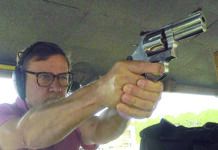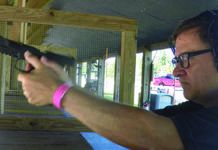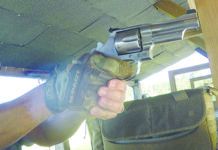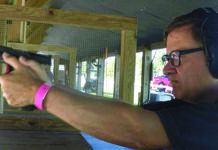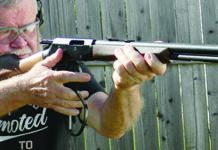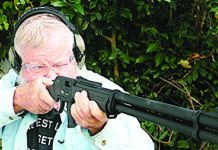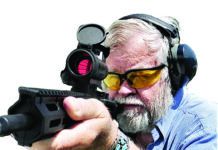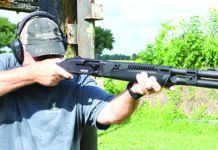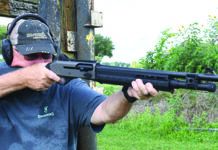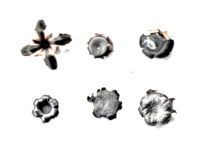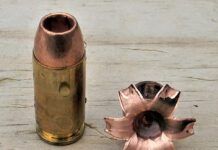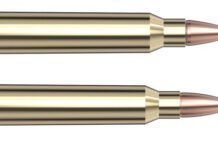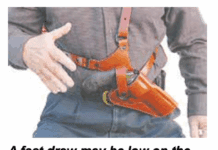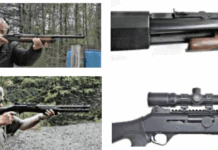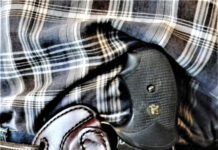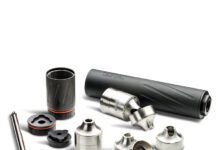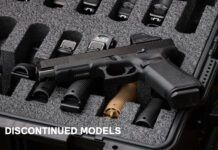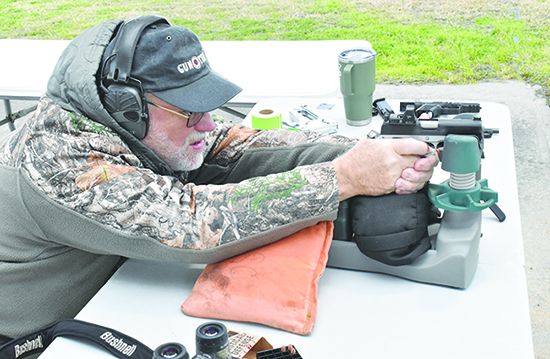Some members of the Houston test group are involved in teaching the Texas License To Carry class. The instruction includes a great deal of information about requirements for carry in Texas and the law regarding usage of those firearms. We also get asked about the best guns for carry. We tell them 1) the gun has to go bang, 2) it has to hit what they point it at, and 3) it needs to be sufficiently powerful. We normally recommend a minimum of 380 ACP. We also strongly suggest carrying a defensive firearm larger than a mouse gun, which tends to be easy to carry but is often difficult to shoot and has limited ammo capacity. Because we’ve never heard anyone who survived a gunfight say that they wish they had had a smaller gun or fewer cartridges, we normally suggest that they select the biggest gun they can, and will, carry.
Once properly enlightened, the LTC students most commonly choose a midsized pistol. The Glock Model 19 may well epitomize that group, but we think there are some other choices that are equally as good, or better. We collected three 9mm Luger samples that all sport less-than-full-length barrels and smaller frames but still maintain sufficient onboard ammo and good sights.
The first offering is one of the latest offerings from Canik. The Canik Mete SF HG5367, $455, ships ready for a red dot (as do the others) and comes compete with a real holster, tools, an extra backstrap, and even a magwell. It also sports one of the shortest, most usable triggers we’ve found on a polymer pistol.
The second is the Glock Model 48 MOS PA4850201FRMOS, $520. Roughly the same length and height as the famous G19, the G48 is slimmer, lighter, and easier to conceal while still allowing 10-round magazines. Of course, 15-round magazines are available aftermarket.
The third is Springfield Armory’s Ronin PX9117LAOS, $700. This is a Commander-length 1911-style pistol with a 4.25-inch barrel, blued slide, aluminum frame, and some very thin grips. Here’s what our shooters thought of these pistols when they fired the handguns side by side.
Springfield Armory Ronin PX9117LAOS 9mm Luger
$700
Gun Tests grade: A [OUR PICK]
We shot the Ronin more accurately and more quickly than either the Glock or Canik. It was also the heaviest pistol here, weighing almost 2 ounces more than the Canik and 8 ounces more than the Glock. The weight made a difference in the shooting. The shooter will have to decide whether to carry that extra weight.
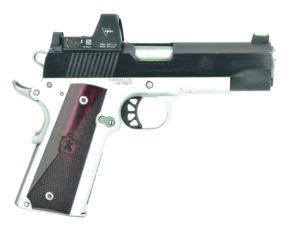
| Action Type | Semi-auto |
|---|---|
| Overall Length | 7.8 in. |
| Overall Height | 5.5 in. |
| Maximum Width | 1.3 in. |
| Weight Unloaded | 27.2 oz. |
| Weight Loaded | 32.0 oz. |
| Slide Material | Forged carbon steel |
| Slide Retraction Effort | 14.1 lbs. |
| Receiver Material | Aluminum alloy |
| Receiver Finish | Cerakote |
| Slide Finish | Blued |
| Front Strap Height | 2.75 in. |
| Back Strap Height | 3.25 in. |
| Barrel Length | 4.25 in. |
| Grip Thickness (Maximum) | 1.145 in. |
| Grip Circumference | 5.25 in. |
| Magazines | (2) 9 round |
| Rear Sight | Drift-adjustable black steel |
| Front Sight | Drift-adjustable fiber optic |
| Sight Radius | 5.75 in. |
| Trigger Pull Weight | 3.3 lbs. |
| Trigger Span | 2.8 in. |
| Safeties | Manual thumb, grip |
| Warranty | Limited lifetime for original owner |
| Telephone | (800) 680-6866 |
| Website | Springfield-Armory.com |
| Made In | U.S. |
We’re not going to call members of this test team old, but several will admit to being well seasoned. We started our careers competing and carrying when the options were a proper revolver, a Browning Hi-Power, or 1911-style pistol. Limit us to these three choices today, and most of us would be just fine. That said, there are now derivatives of those designs that are more conducive to everyday carry. Perhaps our favorite example is “Old Slabsides,” a pistol chambered in 9mm with the Commander-length 4.25-inch barrel and an alloy frame.
Springfield Armory brought out the latest version of what Colt once called the Lightweight Commander last fall. The Springfield Ronin AOS sports the retro look so popular in the late 80s and early 90s. Many of us had blued top ends on our 1911s, with some sort of harder finish on the frame. Electroless nickel plating was a great way to protect our pistols from all that Texas sweat.
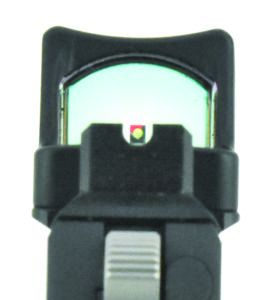
The Ronin accomplishes the same performance with a smoothly polished blued upper and a frame with components that are stainless steel or Cerakoted when alloy is used. The slide is a traditional profile with a rounded top edge and 11 grasping grooves at the rear, and none at the front. It is tear-dropped near the muzzle, in contrast with the heavy, straight sides we see on many guns with an accessory rail. The rails are great for a duty or home-defense weapon. We like our carry guns to be a bit lighter. The Ronin’s ejection port has been dropped and opened. This is a modification from the original Colt design that is expected now, but which was game altering for those of us trying to eject a loaded 45 ACP round in 1984.
Springfield Armory changed out another system some years back that allowed it to make another upgrade with this model. An increasingly litigious society induced Colt to change their pistols’ firing-pin system in the 1980s to a mechanical linkage that would prevent the pistol from firing if dropped on the muzzle. Reasonably simple and effective, it made the trigger pull on those models heavier and left them feeling gritty. Engineers eventually figured out that a very lightweight firing pin and a heavy firing-pin spring would accomplish the same goal without messing up one of the greatest features of a good 1911. Care to guess which system our new Ronin uses? The removal of that mechanical linkage also allows machining on the slide to permit the mounting of reflex sights. Our Ronin came machined with the AOS (Agency Optical System) cuts on the slide. Just remove the two screws and the top plate for access. Springfield offers six different options on the company website. Find which fits your sight and order away. Current cost is $129 per plate, but we have seen special offers on those from time to time. We mounted a Trijicon RMR ($525) that allowed us to co-witness the iron rear sight with the fiber-optic front. We think that is the best of both worlds. Just as a note on all of these pistols — blue Loctite is a great thing when you mount red-dot sights.
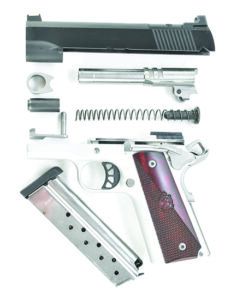
The Ronin’s frame is made of aluminum, which can be problematic, but not on the Ronin. We’ve seen a number of alloy frames that pair with a standard barrel feed ramp. In that system, the bullet pushes out of the magazine and hits the lower part of the feed ramp — in this example, still part of the frame. We have personally seen where hollow-point rounds have gouged the frame, eventually causing feeding issues. With the Ronin, Springfield uses a fully ramped barrel, meaning the feed ramp is integral to the barrel and made of the same hard steel. Problem solved. The standard-profile barrel is 4.25 inches long, no bull barrel on this carry gun. Lockup was great, with no apparent movement of the barrel hood, even when the hammer was cocked and the safety off. Controls are left side only, though an ambidextrous safety is an easy add. The mainspring housing is stainless steel and checkered at 20 lines per inch. The front strap is very smooth, so much so that we added a thin strip of skateboard tape. The trigger has a polymer shoe that is not adjustable for overtravel, though there was very little present. The alloy frame is Cerakoted to a tone very nearly matching the stainless-steel parts, and the magwell is beveled. The grips sport the Springfield Armory crossed cannons and are very thin in their own right, all adding to the concealability of the package. Standard capacity is nine rounds using the supplied magazines, making the initial payload an easy to remember 9+1 with one in the tube. Many of the aftermarket mags you’ll find (like the good ones like from Wilson) are 10-rounders that protrude from the base of the magwell. We prefer the nine-round flush-fits mags we sourced from Colt for actual carry. Our mag pouches always carry the +1 mags.
You can’t shake a tree without having a 1911 holster fall out, but holsters made for 1911s with red-dot sights attached are less common. We do a lot of our range work with Kydex holsters, but our shooters prefer leather models for carry. They’re just more comfortable. We’ve had great luck with Galco Leather Combat Master belt holsters. However, we checked and found they didn’t offer one for a 1911 with a mounted red dot. We also found out that all we had to do was call them and their Custom Shop fixed that for us. It only took a couple of extra weeks and a little cash to get our own custom-built rig.
Our Team Said: The Ronin from Springfield Armory fed and fired everything perfectly. It averaged a mere 1.34 inches across five-shot groups from three different kinds of ammo. It also recorded the fastest times in our shooting drills. We’ve already noted the weight difference on this 1911- style pistol which, along with that marvelous trigger, really does make for an advantage. The very factors that make it a bit easier to shoot also make it a bit more difficult to conceal. Shooters will have to decide which factors are the most important to them when making their buying decisions.
| 9MM LUGER RANGE DATA | |||
|---|---|---|---|
| Hornady Critical Defense 115-grain FTX 90260 | Springfield Ronin | Glock Model 48 | Canik Mete SF |
| Average Velocity | 1164 fps | 1126 fps | 1130 fps |
| Muzzle Energy | 346 ft.-lbs. | 324 ft.-lbs. | 326 ft.-lbs. |
| Best Group | 0.81 in. | 1.54 in. | 0.93 in. |
| Average Group | 1.28 in. | 1.72 in. | 1.25 in. |
| Aguila Ammunition 124-grain FMJ 1E092110 | Springfield Ronin | Glock Model 48 | Canik Mete SF |
| Average Velocity | 1121 fps | 1083 fps | 1109 fps |
| Muzzle Energy | 346 ft.-lbs. | 323 ft.-lbs. | 339 ft.-lbs. |
| Best Group | 1.00 in. | 1.43 in. | 1.42 in. |
| Average Group | 1.33 in. | 1.76 in. | 2.37 in. |
| Fiocchi Range Dynamics 147-grain FMJ 9APD | Springfield Ronin | Glock Model 48 | Canik Mete SF |
| Average Velocity | 977 fps | 939 fps | 943 fps |
| Muzzle Energy | 312 ft.-lbs. | 288 ft.-lbs. | 290 ft.-lbs. |
| Best Group | 1.23 in. | 1.47 in. | 1.13 in. |
| Average Group | 1.42 in. | 1.55 in. | 1.54 in. |
We compared our test guns at American Shooting Centers (AMShootCenters.com) in west Houston. We tested using three different types of ammunition. We started off with Hornady 115-grain Critical Defense loads, Aguila 124-grain full metal jackets, as well as Fiocchi 147-grain Range Dynamics FMJs. For accuracy, we fired five-shot groups at 15 yards from a well-sandbagged Caldwell Pistolero Shooting Rest (MidwayUSA.com 517357, $28) assisted by a Mini DRC Fortune Cookie from Wiebad.com (MINIFC, $75). We also wanted to test practical accuracy, so we did two additional tests. The first used 3-by-5 inch stickies attached to paper targets 5 yards downrange. We recorded first-shot times using 124-grain ammo. Then we shot three rounds, also at 5 yards, and using the same 3-by-5 inch label. The start position on all drills was from low ready. Velocities were obtained via the new Garmin Xero C1 Pro (Amazon, $600).
| DRILL NO. 1 DATA | |
|---|---|
| Pistol | Single Shot Average Time |
| Canik Mete SF | 0.78 |
| Glock Model 48 | 0.81 |
| Springfield Armory | 0.68 |
Process: Fire one shot from low ready at 3-by-5-inch label placed at 5 yards. Times in seconds are averages for eight repetitions.
| DRILL NO. 2 DATA | |||
|---|---|---|---|
| Pistol | 1st Shot | Split Average | Total Time |
| Canik Mete SF | 0.94 | 0.2 | 1.34 |
| Glock Model 48 | 0.99 | 0.26 | 1.51 |
| Springfield Armory | 0.72 | 0.2 | 1.12 |
Process: Fire three shots from low ready at 3-by-5-inch label placed at 5 yards. Times in seconds are averages for three repetitions.
Written and photographed by Joe Woolley, using evaluations from Gun Tests Team members. GT



